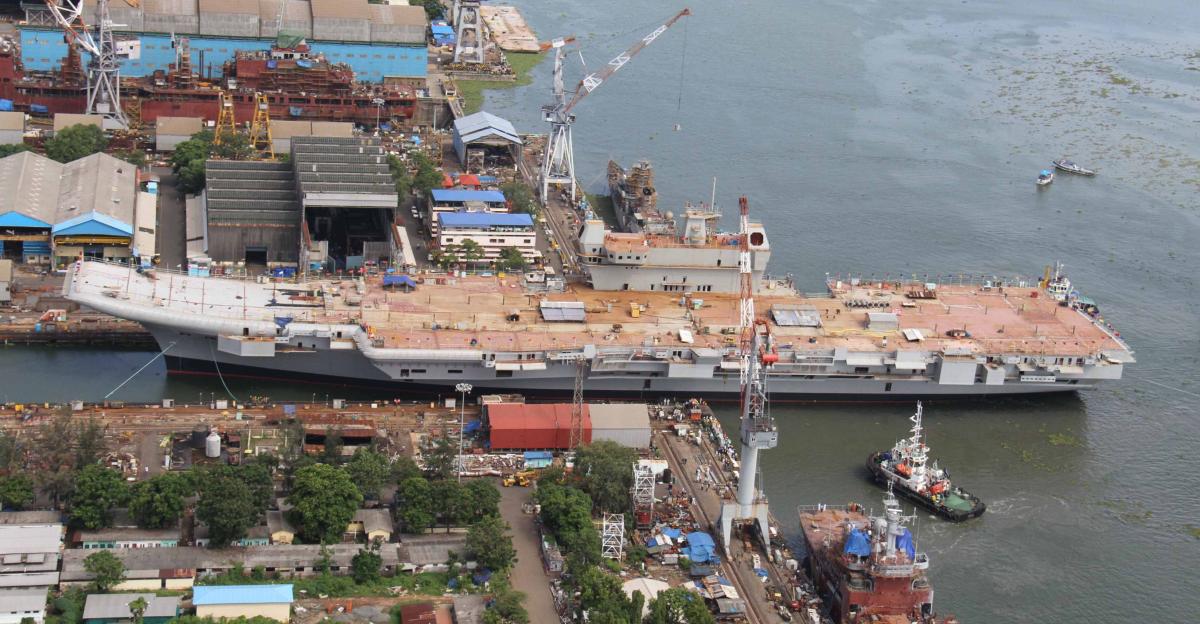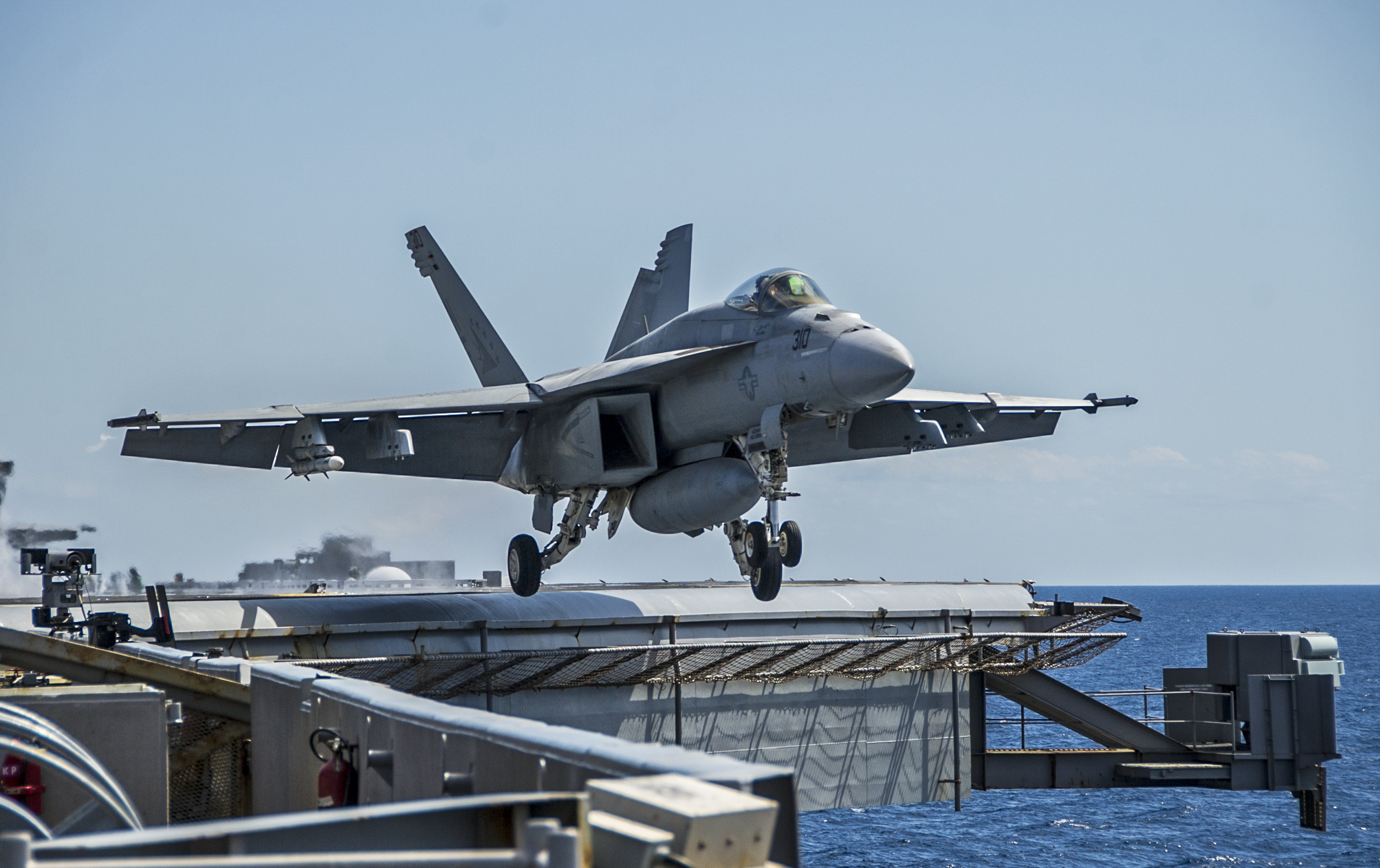
Could India’s planned indigenous ‘flat-top’ aircraft carrier, designated the Vishal-class, be on hold — or at the very least, the subject of a formal rethink? A series of indications this week suggest that the Indian government may not be speeding towards the Vishal under the Indian Navy’s long-standing doctrinal pressures for a 3-carrier navy.
The navy currently operates the INS Vikramaditya aircraft carrier and will, within the next two years, induct the similarly configured Vikrant, the first indigenously designed and built aircraft carrier in the country. The Vishal, forward planned as a break-away from the traditional ski-jump fitted carriers, is proposed to incorporate a catapult-based launch system. The configuration of the Vishal has been the subject of much discussion and debate over the last decade, with key design decisions — like the decision not to have a ski-jump for aircraft launch — taken in just the last few years. But rumours of a rethink on how soon, and whether the Vishal program will be embarked upon is now up for question.
For starters, India’s first Chief of Defence Staff General Bipin Rawat provided an unmissable indicator in his first detailed interview since taking strength in the newly created tri-service chief appointment that involves long-term acquisitions and planning within the confines of highly squeezed budgets. In response to a specific question on aircraft carriers by News18 journalist Shreya Dhoundial, General Rawat said, “One aircraft carrier will be on the seas next year. You look at when do you really need a third one. If you get a third one, how many years will it take for it to develop? Even if you place the order for 2022 or 2023, it is not coming before 2033. Also, aircraft carrier is not just a carrier, along with it will have to come the aircraft. Where are the aircraft coming from? Along with that we will need the armada protection for that aircraft carrier. It does not happen overnight. It will be bought if it is required. But you cannot predict what the situation will be 10 years from now. We don’t know what will happen.”

His comments come in the wake of what has been a steady conversation on the Vishal, particularly over whether the ship would employ U.S. supplied EMALS (electromagnetic aircraft launch system) and reports in the British press claiming that the Elizabeth-class carrier’s blueprints had been sought by the Indian government in an effort to modify it for the proposed Vishal-class in an effort to reduce timelines. Running underneath these developments, however, there’s been unmissable sign that the Vishal was already a faraway castle, with no formal financial sanction from the Indian MoD, and a debate within government over whether a three-carrier navy was too much of an opulence in these financially strained times.
Another crucial indicator of the receding figure of the Vishal emerged earlier this month when Boeing revealed at the DefExpo 2020 show that it would shortly be testing its F/A-18 Super Hornet on a ski-jump platform at Naval Air Station Patuxent River, Maryland. Dassault Aviation, which, like Boeing, has so far conducted simulations of the Rafale on a ski-jump, could also look at proving the aircraft in a real test setting going forward, though there are no firm plans for now.

While it has generally been believed that the Indian Navy’s forecast requirement for 57 multirole carrier based fighters (MCRBF) were intended, at least in part, with the catapult-configured deck of the Vishal in view, the reality is actually significantly different. After conversations with the Indian Navy, Livefist can now confirm that the 57 jets being sought are fully and officially to meet the the combined requirement of INS Vikramaditya and the upcoming Vikrant/IAC1, in addition to a full shore-based training squadron. This position has been conveyed in discussions that the Indian Navy has held with both Boeing and Dassault.
Senior Indian Navy sources told Livefist, “The 57 deck based fighters (DBF) has is to meet the combined additional requirement of the current and next carrier, in addition to a training squadron we will be raising. Any conversation about aircraft for the proposed IAC2/Vishal will necessarily be only in the future.”
The jets will be ‘additional’ to the MiG-29K jets that currently form the carrier wing on INS Vikramaditya — and will, according Indian Navy chief Admiral Karambir Singh two months ago — operate off the IAC1 as well.
Boeing’s move to prove the Super Hornet from a ski-jump has very much to do with the Vikrant/IAC1’s nearing date of entry into service. The company has, for years now, said it has conducted simulations to prove the compatibility of the Super Hornet with India’s current and next carrier.
https://www.facebook.com/Livefist/videos/1505363796168905/
Significant questions have continued to swirl, however, over whether the Super Hornet and Rafale are truly 100% compatible with the size, space and mechanical system configuration on the INS Vikramaditya and IAC1. This would pertain, among other things, to their hydraulic deck chocks and the busy deck conditions typical of Russian-influenced deck design, unlike the larger and very different configurations of the Nimitz-class and Charles de Gaulle that house the U.S. and French carrier jets respectively. It remains to be seen how the Indian Navy plans to navigate and address these incompatibilities as it moves forward on this acquisition program.
Earlier this month, the MoD updated Parliament on progresson the IAC1 thus: Major structural and outfitting work of Indigenous Aircraft Carrier (IAC1) has been completed. Major milestone activities including starting of Main Propulsion machinery and trials of Power Generation machinery have been completed. Trials of other ship’s equipment and systems are presently in progress. Ship’s targeted delivery was affected due to delay in supply of aviation equipment from Russia.
The IAC1 is expected to enter sea trials late this year or early next, with scheduled entry into service in 2022.
Also read: HISTORY: India’s LCA Makes 1st Landing On Aircraft Carrier Deck
And: India’s DRDO Forced To Ditch LCA Navy Mk2 For Cleansheet Twin-Engine Jet Design

Can you please explain why are more 57planes required? Since vikramaditya and vikrant can carry 1 sqadron each, dont we have enough mig’s already? This question is puzzling me.
DUDE IT HAS 2 SQUADRONS BUTH IN TURNS THEY ARE USED SO THEY NOW REDUCED THE EQUIREMENT TO ONLY 36
I’m not sure why the IN is still banking on mig 29k? It was last reported that availability rates were abysmal and that the planes could not handle the rough landings during carrier operations. Has this been addressed ? They are better off assigning the mig 29s to shore based duties and build upon Rafale and LCA squadrons for IN carriers.